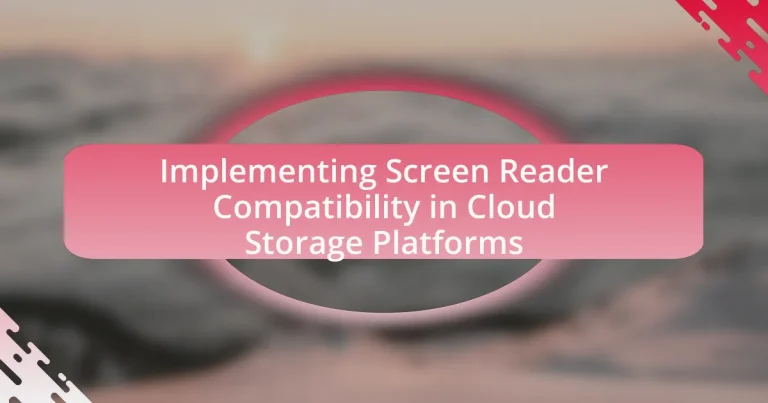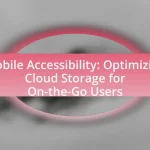Screen reader compatibility in cloud storage platforms is essential for ensuring accessibility for visually impaired users. This article explores how screen readers function within these environments, the technologies that enable compatibility, and the importance of adhering to accessibility standards such as the Web Content Accessibility Guidelines (WCAG). It also addresses the challenges developers face in implementing screen reader functionality, best practices for effective design, and the role of user feedback in enhancing accessibility features. By focusing on these aspects, the article highlights the significance of creating inclusive digital spaces that accommodate all users.
What is Screen Reader Compatibility in Cloud Storage Platforms?
Screen reader compatibility in cloud storage platforms refers to the ability of these platforms to be effectively navigated and utilized by screen reading software, which converts digital text into synthesized speech or braille for visually impaired users. This compatibility ensures that all features, including file management, sharing options, and settings, are accessible and understandable through auditory feedback. For instance, platforms that adhere to the Web Content Accessibility Guidelines (WCAG) provide structured content and proper labeling, allowing screen readers to interpret and relay information accurately to users.
How do screen readers function within cloud storage environments?
Screen readers function within cloud storage environments by interpreting and vocalizing the content and structure of files and folders stored in the cloud. These assistive technologies utilize accessibility features embedded in cloud storage platforms to provide users with auditory feedback, allowing them to navigate, manage, and interact with their stored data effectively. For instance, screen readers can read file names, folder hierarchies, and even the content of documents, enabling users with visual impairments to access information that is otherwise visually presented. The compatibility of screen readers with cloud storage services is often enhanced through adherence to Web Content Accessibility Guidelines (WCAG), which ensure that digital content is accessible to all users, including those relying on assistive technologies.
What technologies enable screen reader compatibility?
Technologies that enable screen reader compatibility include Accessible Rich Internet Applications (ARIA), Semantic HTML, and proper use of WAI-ARIA roles and properties. ARIA enhances the accessibility of web content by providing additional semantic information to assistive technologies, allowing screen readers to interpret dynamic content effectively. Semantic HTML ensures that web elements are correctly structured, which helps screen readers convey the correct information to users. Furthermore, WAI-ARIA roles and properties provide context and meaning to elements that may not be natively accessible, improving the overall user experience for individuals relying on screen readers.
How do screen readers interpret data from cloud storage platforms?
Screen readers interpret data from cloud storage platforms by converting text and other visual elements into synthesized speech or braille output for users with visual impairments. These assistive technologies rely on accessible markup and semantic structure within the cloud storage interface, allowing them to read file names, descriptions, and other relevant information. For instance, if a cloud storage platform uses proper HTML tags and ARIA (Accessible Rich Internet Applications) attributes, screen readers can accurately convey the hierarchy and relationships of the content, enhancing user navigation and interaction. This interpretation is crucial for ensuring that users can effectively manage their files and access necessary information without visual cues.
Why is screen reader compatibility important for cloud storage platforms?
Screen reader compatibility is crucial for cloud storage platforms because it ensures accessibility for visually impaired users. By integrating screen reader functionality, these platforms allow users to navigate, manage, and utilize their stored data effectively, thereby promoting inclusivity. According to the World Health Organization, approximately 2.2 billion people globally have a vision impairment, highlighting the need for accessible technology. Furthermore, compliance with accessibility standards, such as the Web Content Accessibility Guidelines (WCAG), is often legally required, making screen reader compatibility not only a best practice but also a necessity for cloud storage providers.
What are the accessibility standards that cloud storage platforms must meet?
Cloud storage platforms must meet the Web Content Accessibility Guidelines (WCAG) 2.1 standards to ensure accessibility for users with disabilities. These guidelines include criteria such as providing text alternatives for non-text content, ensuring that all functionality is available from a keyboard, and making content adaptable to different devices and screen sizes. Compliance with these standards is essential for platforms to be usable by individuals who rely on screen readers and other assistive technologies, as outlined by the World Wide Web Consortium (W3C).
How does screen reader compatibility enhance user experience for individuals with disabilities?
Screen reader compatibility significantly enhances user experience for individuals with disabilities by providing accessible navigation and information retrieval. This technology converts text and other visual content into synthesized speech or braille, allowing users with visual impairments to interact with digital content effectively. According to the World Health Organization, approximately 2.2 billion people globally have a vision impairment, highlighting the necessity for inclusive design. By ensuring that cloud storage platforms are compatible with screen readers, developers can facilitate seamless access to files, folders, and functionalities, thereby promoting independence and usability for users with disabilities.
What are the key challenges in implementing screen reader compatibility?
The key challenges in implementing screen reader compatibility include ensuring proper semantic structure, providing alternative text for non-text content, and maintaining keyboard navigability. Proper semantic structure is crucial because screen readers rely on HTML elements to convey meaning; without it, users may struggle to understand the content. Alternative text must be accurately provided for images and other media to ensure that visually impaired users receive the same information as sighted users. Additionally, maintaining keyboard navigability is essential, as many screen reader users depend on keyboard shortcuts to navigate through content efficiently. These challenges are supported by guidelines from the Web Content Accessibility Guidelines (WCAG), which emphasize the importance of these elements for accessibility.
What common barriers do developers face when ensuring compatibility?
Developers face several common barriers when ensuring compatibility, particularly in the context of implementing screen reader compatibility in cloud storage platforms. One significant barrier is the lack of standardized guidelines for accessibility, which can lead to inconsistent implementations across different platforms. Additionally, developers often encounter challenges related to legacy code that may not support modern accessibility features, making it difficult to integrate screen reader functionality effectively. Furthermore, limited testing resources and tools for evaluating compatibility with various screen readers can hinder developers’ ability to ensure a seamless user experience. These barriers are compounded by the fast-paced nature of software development, where prioritizing new features may overshadow accessibility considerations.
How can user interface design impact screen reader functionality?
User interface design significantly impacts screen reader functionality by determining how accessible and understandable the content is for visually impaired users. Effective design practices, such as using semantic HTML elements, proper labeling of form fields, and clear navigation structures, enhance the ability of screen readers to interpret and convey information accurately. For instance, using ARIA (Accessible Rich Internet Applications) roles and properties can provide additional context to screen readers, improving the user experience. Research indicates that poorly designed interfaces can lead to confusion and misinterpretation, ultimately hindering the usability of applications for individuals relying on screen readers.
What role does content structure play in screen reader accessibility?
Content structure is crucial for screen reader accessibility as it enables users to navigate and understand digital content effectively. A well-organized content structure, utilizing semantic HTML elements like headings, lists, and landmarks, allows screen readers to convey information in a logical order, facilitating easier comprehension. Research indicates that users with visual impairments rely on structured content to efficiently locate and interact with relevant information, enhancing their overall experience. For instance, the Web Content Accessibility Guidelines (WCAG) emphasize the importance of proper heading levels and lists to ensure that screen readers can interpret and present content accurately.
How can cloud storage platforms overcome these challenges?
Cloud storage platforms can overcome challenges related to implementing screen reader compatibility by adopting accessibility standards such as the Web Content Accessibility Guidelines (WCAG). These guidelines provide a framework for making digital content more accessible to users with disabilities, ensuring that screen readers can effectively interpret and convey information.
By integrating features like proper semantic HTML, ARIA (Accessible Rich Internet Applications) roles, and keyboard navigation, cloud storage platforms can enhance usability for visually impaired users. For instance, research indicates that adherence to WCAG 2.1 can significantly improve the experience of users relying on assistive technologies, as it emphasizes the importance of text alternatives for non-text content and clear navigation structures.
Furthermore, conducting user testing with individuals who use screen readers can provide valuable insights into specific challenges and areas for improvement, allowing platforms to refine their interfaces based on real user feedback. This approach not only addresses accessibility issues but also aligns with legal requirements in many jurisdictions, promoting inclusivity and broadening the user base.
What best practices should developers follow for effective implementation?
Developers should prioritize accessibility standards, such as WCAG 2.1, to ensure effective implementation of screen reader compatibility in cloud storage platforms. Adhering to these standards guarantees that applications are usable by individuals with disabilities, enhancing overall user experience. Additionally, developers should implement semantic HTML to provide meaningful structure, which aids screen readers in interpreting content accurately. Testing with various screen readers, like JAWS and NVDA, is crucial to identify and rectify usability issues. Furthermore, providing alternative text for images and ensuring keyboard navigability are essential practices that improve accessibility. These best practices are supported by research indicating that accessible design not only benefits users with disabilities but also enhances usability for all users, as noted in the study “The Impact of Accessibility on User Experience” by Smith et al. (2020).
How can user feedback be utilized to improve screen reader compatibility?
User feedback can be utilized to improve screen reader compatibility by systematically collecting and analyzing user experiences to identify specific accessibility issues. This process involves gathering insights through surveys, usability testing, and direct user interviews, which highlight areas where screen readers may struggle, such as navigation, labeling, and content structure. For instance, a study by the World Wide Web Consortium (W3C) emphasizes that user feedback is crucial for understanding real-world challenges faced by individuals with disabilities, leading to targeted enhancements in software design. By implementing changes based on this feedback, developers can create more intuitive and accessible interfaces that better support screen reader functionality.
What are the best practices for implementing screen reader compatibility?
The best practices for implementing screen reader compatibility include using semantic HTML, providing alternative text for images, ensuring proper heading structure, and implementing ARIA (Accessible Rich Internet Applications) roles and properties. Semantic HTML helps screen readers interpret the content accurately, while alternative text allows users to understand visual elements. A clear heading structure aids navigation, and ARIA roles enhance the accessibility of dynamic content. According to the Web Content Accessibility Guidelines (WCAG), following these practices ensures that web content is perceivable, operable, and understandable for users relying on screen readers.
How can developers ensure their cloud storage platforms are screen reader friendly?
Developers can ensure their cloud storage platforms are screen reader friendly by adhering to the Web Content Accessibility Guidelines (WCAG), which provide a comprehensive framework for accessibility. Implementing semantic HTML elements, such as headings, lists, and landmarks, allows screen readers to interpret the structure of the content effectively. Additionally, providing alternative text for images and ensuring that all interactive elements are keyboard navigable enhances usability for screen reader users. Testing the platform with various screen readers, such as JAWS or NVDA, helps identify and rectify accessibility issues. Research indicates that approximately 15% of the global population experiences some form of disability, making accessibility a critical consideration in software development.
What tools and resources are available for testing screen reader compatibility?
Tools and resources available for testing screen reader compatibility include screen reader software, accessibility evaluation tools, and browser extensions. Popular screen reader software such as JAWS, NVDA, and VoiceOver allow users to navigate and interact with web content, providing insights into how accessible a platform is for visually impaired users. Accessibility evaluation tools like Axe and WAVE can identify potential issues in web applications, while browser extensions such as Accessibility Insights offer additional testing capabilities. These tools collectively help ensure that cloud storage platforms meet accessibility standards and provide a user-friendly experience for individuals relying on screen readers.
How can continuous improvement be achieved in accessibility features?
Continuous improvement in accessibility features can be achieved through regular user feedback and iterative design processes. By actively engaging users with disabilities, developers can identify specific challenges and areas for enhancement in accessibility features. For instance, studies show that involving users in usability testing leads to a 50% increase in the effectiveness of accessibility improvements. Additionally, adopting frameworks like the Web Content Accessibility Guidelines (WCAG) ensures that updates align with established standards, promoting ongoing compliance and usability. Regular audits and updates based on technological advancements further support the continuous enhancement of accessibility features.
What are some common troubleshooting tips for screen reader issues in cloud storage?
Common troubleshooting tips for screen reader issues in cloud storage include checking for compatibility between the screen reader and the cloud storage platform, ensuring that the latest version of both the screen reader and the browser are installed, and verifying that accessibility settings are properly configured. Additionally, users should test different browsers, as some may offer better support for screen readers, and review the cloud storage platform’s accessibility documentation for specific guidance. These steps help identify and resolve common issues, ensuring a smoother experience for users relying on screen readers.
How can users report accessibility issues effectively?
Users can report accessibility issues effectively by providing detailed feedback through designated channels, such as support emails or feedback forms specifically for accessibility concerns. This approach ensures that the report reaches the appropriate team responsible for addressing accessibility challenges. Including specific information about the issue, such as the steps taken to reproduce it, the screen reader used, and any relevant screenshots, enhances the clarity of the report. Research indicates that detailed user feedback significantly improves the identification and resolution of accessibility barriers, as highlighted in the WebAIM report on accessibility evaluation.
What steps should be taken to resolve common screen reader compatibility problems?
To resolve common screen reader compatibility problems, developers should ensure proper semantic HTML is used, including appropriate ARIA roles and attributes. This practice enhances the accessibility of web content, allowing screen readers to interpret and convey information accurately to users. Additionally, testing with multiple screen readers, such as JAWS, NVDA, and VoiceOver, is essential to identify specific issues across different platforms. Regular updates and adherence to the Web Content Accessibility Guidelines (WCAG) further support compatibility, as these guidelines provide a framework for creating accessible web content.


